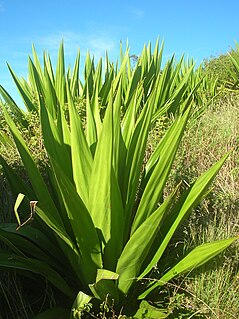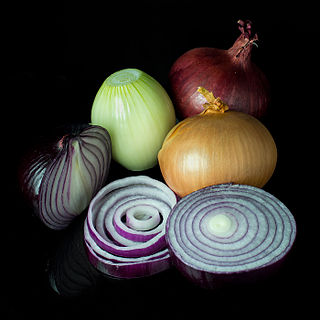
Furcraea foetida is a species of flowering plant native to the Caribbean and northern South America. It is widely cultivated and reportedly naturalized in many places

Lilium davidii is an Asian species of plants in the lily family, native to mountainous areas of Assam, Manipur, Arunachal Pradesh, Tibet, Bhutan, Hubei, Shaanxi, Sichuan, Guizhou, and Yunnan.
Triplopogon is a genus of plants in the grass family. The only known species is Triplopogon ramosissimus, native to Maharashtra, India.
Hubbardia is a genus in the grass family that is endemic to India. It is the only genus in the Hubbardieae tribe of the Micrairoideae subfamily.
Indopoa is a genus of Indian plants in the grass family. The only known species is Indopoa paupercula, native to the States of Maharashtra and Karnataka in India.
Lasiurus is a genus of Asian and African plants in the grass family, found primarily in arid regions. The only known species is Lasiurus scindicus, native to drier regions of northern Africa and southwestern Asia, from Morocco and Mali to India.
Leptaspis is a genus of Paleotropical plants in the grass family, native to Africa, southern Asia, northern Australia, and a few islands of the western Pacific.
- Leptaspis angustifoliaSummerh. & C.E.Hubb. - New Guinea, Fiji
- Leptaspis banksiiR.Br. - Queensland, New Caledonia, New Guinea, Solomon Islands, Philippines, Taiwan, Sulawesi, Malaysia, Java, Lesser Sunda Islands, Thailand
- Leptaspis zeylanicaNees ex Steud. - tropical Africa from Liberia to Ethiopia to Zimbabwe; Madagascar, Comoros, Sri Lanka, Java, Malaysia, Sumatra, Sulawesi, New Guinea, Solomon Islands
Manisuris is a genus of Indian plants in the grass family. The only known species is Manisuris myuros, native to Tamil Nadu in southern India.
Myriostachya is a genus of Asian plants in the grass family. The only known species is Myriostachya wightiana, native to India, Bangladesh, Sri Lanka, Myanmar, Thailand, Sumatra, and Peninsular Malaysia.
Ochthochloa is a genus of desert plants in the grass family native to the Sahara and Arabian Deserts. The only known species is Ochthochloa compressa, whose native range extends from Algeria to Uttarakhand.

Lilium wallichianum is an Asian species of bulbous plants in the lily family native to the Indian Subcontinent and to Myanmar. It is native to India, as well as Nepal, Bhutan, and Myanmar.
Sida mysorensis, common name in India Mysore fanpetals, is a plant species native to South and Southeast Asia. It has been reported from the wild in Indonesia, Vietnam, Laos, Cambodia, Thailand, India, Pakistan and southern China, and is cultivated elsewhere. It grows in grassy slopes, on roadsides, and in forest boundaries.

Allium fasciculatum is a species of onions known from the Himalayas of Bhutan, Sikkim, Nepal, and the Chinese provinces of Qinghai, Sichuan and Tibet. It grows at elevations of 2200–5400 m.
Allium consanguineum is a species of onion found high in the Himalayas of northern Pakistan and northern India. It is a perennial herb up to 35 cm tall, with an egg-shaped bulb. Leaves are flat, narrow. Umbels are hemispherical, densely crowded with many yellow or pink flowers.
Allium farctum is an Asian species of onions found high in the mountains of Pakistan and Afghanistan. It is a bulb-forming perennial up to 70 cm tall, producing a bulb up to 25 mm across. Flowers are white, borne in a tightly packed hemispheric umbel.
Najas kurziana, called the Bihar water nymph, is an aquatic plant growing in fresh water ponds. It is a rare and little-known species known from East Timor and from the State of Bihar in India. The species was initially discovered between Kishenganj and Oolabena, near the border with Nepal.

Orthanthera is a genus of plants in family Apocynaceae, first described as a genus in 1834. It is native to India and Africa.
- Orthanthera albidaSchinz - Namibia
- Orthanthera butayei(De Wild.) Werderm. - Zaire
- Orthanthera gossweileriC.Norman - Angola
- Orthanthera jasminiflora(Decne.) N.E.Br. ex Schinz - South Africa
- Orthanthera strictaHiern - Angola
- Orthanthera vimineaWight - Uttar Pradesh in India
Gagea bulbifera is a Eurasian species of plants in the lily family, widespread from Romania to Xinjiang. It is native to Romania, Russia, South Caucasus, Kazakhstan, Kyrgyzstan, Iran, Turkey, Xinjiang, Western Himalayas.
Gagea olgae is an Asian species of plants in the lily family. It is native to Iran, Pakistan, Afghanistan, Kyrgyzstan, Tajikistan, Uzbekistan, Kazakhstan, and Xinjiang.
Gagea kunawurensis is an Asian species of plants in the lily family. It is native to Central Asia, Xinjiang, Afghanistan, Iran, Pakistan, Western Himalayas, and South Caucasus.







